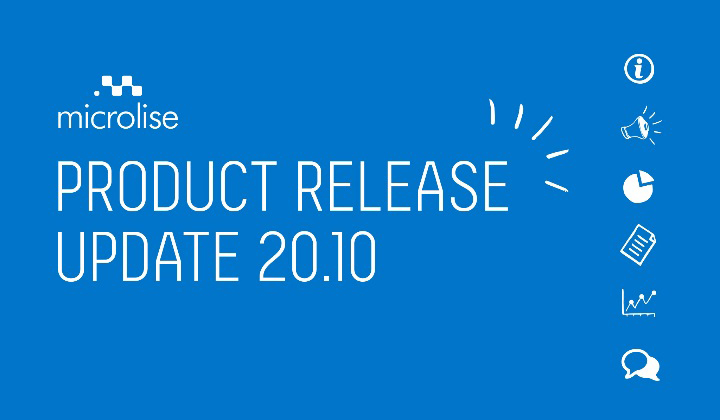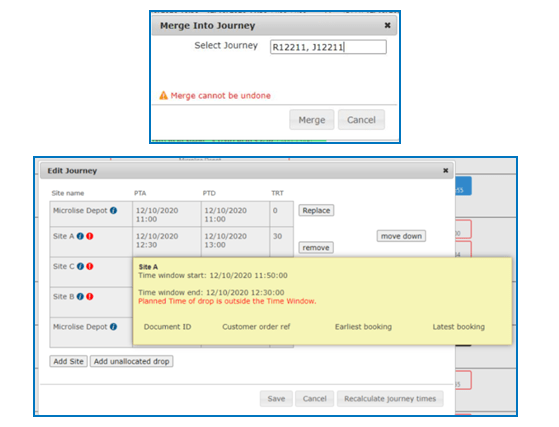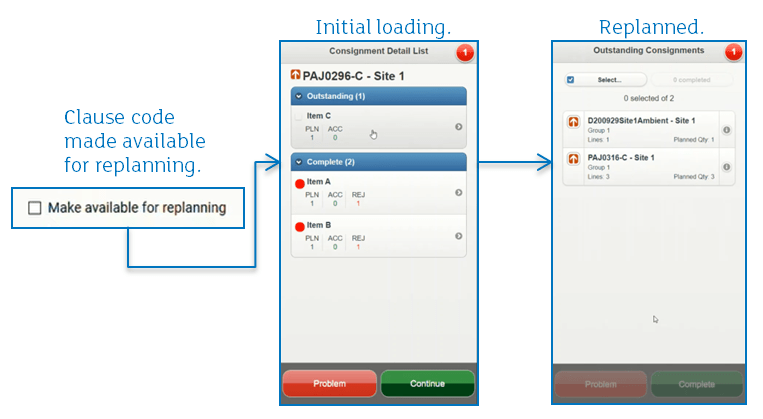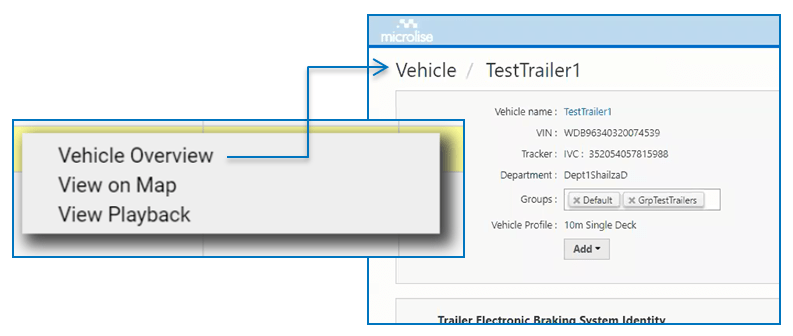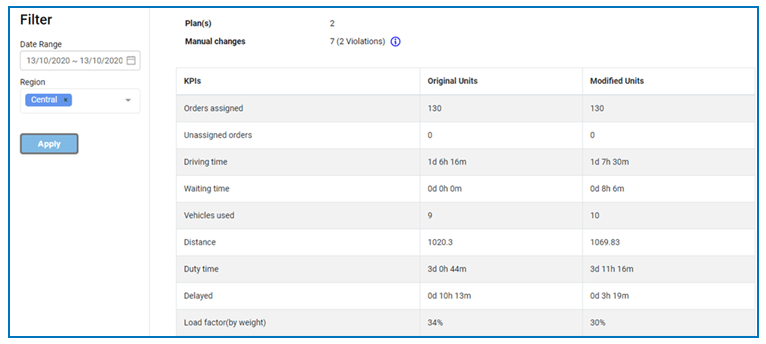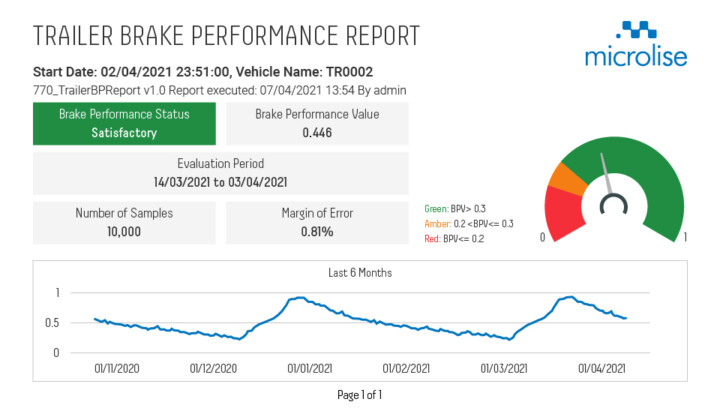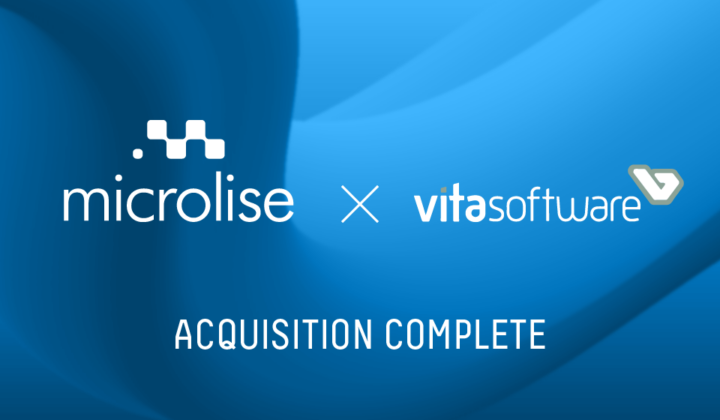Receiving feedback from our customers is always important to us, particularly as it helps us to develop new functionality. The 20.10 release is a perfect example of this. The addition of a comments feature in the 560 Vehicle Off Road report, allowing users to provide added contextual information for their off-road vehicles, was developed in response to a customer suggestion during one of our earlier product release webinars.
The 20.10 release introduces new and improved features across our product range, including new quick reports and expanding the capability of our vehicle off road functionality.
JOURNEY MANAGEMENT
When creating journeys in the Web Portal, customers with our Journey Management solution now have the option to merge two journeys that are at ‘new’ status and begin in the same location. This will allow customers to incorporate rush orders through the system alongside their planned orders.
This process will also alert users to any journey drops that are outside the time window for the merged journey, and will raise a new corresponding ‘JM’ event in the Journey History page so that a merge taking place is clearly recorded for any other users, or for auditing purposes. This can similarly be highlighted during the debriefing process, where a user wishes to add comments to provide extra context around why a journey was merged alongside what is visible on the Journey History page.
The journey debrief area of the Web Portal has also been enhanced with the 20.10 release – specifically, the driver tasks area (section 1.5.2) of the debrief page, where web portal users can see the tasks assigned to their drivers. New icons have been introduced alongside tasks to indicate whether a task was passed, failed, not applicable, or the driver did not select anything in response. This will help to clarify what tasks were undertaken at a glance and indicate areas of concern for office staff during the debrief process, making the process faster and easier to complete.
EPOD MOBILE APPS
The SmartPOD app can now support automatically displaying items which have been claused during the loading process for any reason (and therefore prevented from delivery) on the next available journey to the same site instead. When a driver uses a specific clause code, as defined via the Web Portal, a new consignment will be generated with the related items already contained within it.
This process is simple and quick for Web Portal administrators to set up, with the inclusion of a new “Make Available For Replanning” checkbox allowing users to decide at the click of a button, which specific clause codes they would like to trigger the automatic replanning process. Web Portal users can also now control which tasks are accessible from the departure screen within SmartPOD via a similar ‘Include On Departure Screen’ checkbox.
Any tasks selected – for example, recording the return of a delivered item because the end customer decides not to accept it – will be shown as a button on the Site Departure screen. Tasks can be completed by a driver multiple times if necessary before they opt to depart a site, as each time one is completed they will then be returned straight to the Site Departure screen. This will help to facilitate more efficient deliveries, and our available task activity reports can help to provide Web Portal users with additional information around the process for monitoring purposes as and where necessary.
Previously, if only one consignment was planned for a site visit, the SmartPOD app would skip the consignment screen when beginning the process to make a delivery, which would sometimes result in a driver delivering a lot of items and having to add any required clause codes on a line-by-line basis. Following the 20.10 release, it is now possible to enable the SmartPOD app to show the consignment screen regardless of how many consignments are planned. This simplification for drivers using the app will help ensure a faster, more consistent delivery process and an improved doorstep experience for end customers.
As part of the 20.10 release, the SmartPOD app can now automatically set a vehicle to ‘Vehicle Off Road’ (VOR) status when a vehicle check task is failed by creating a VOR record against it in the system. Web Portal users can specify which types of vehicle check will set this status, and can also review which vehicles have a VOR record from the Web Portal alongside the name of the driver that triggered the failed vehicle check. Customers should note that this functionality is not currently recommended in a case where vehicle checks occur on trailer swaps but will be fully functional in the next release.
If a vehicle has been set to VOR status for whatever reason, the SmartPOD app will prevent a driver from using it to complete journeys and from searching for the vehicle via its Vehicle ID. Drivers who attempt this will be shown an error message, advising them to either use a different vehicle or contact transport office staff to have the VOR status removed, as they cannot do this themselves within the app. They will then be redirected to either the vehicle entry screen or the on-shift screen depending on previous activities.
FLEET PERFORMANCE
Tying in with the additions around VOR vehicles within the SmartPOD app in this release, customers utilising their fleet with Fleet Performance can utilise the additional comments column added to the 560 Vehicle Off Road report to give themselves a quick and easy view of all the vehicles in their fleet which have VOR status and – more importantly – understand the cause of the VOR status via any comments added to provide extra context.
This can help provide fleet managers and operations staff with an understanding of when their vehicles are likely to cycle back into availability for use (for example, a vehicle that is VOR for failing a minor vehicle check is likely to be ready sooner than one with a more serious fault that requires maintenance) and results can be exported for further analysis or subscribed to, so that users can receive automated information via their inbox, making it simple and easy to access and use it to inform their decisions.
A drop-down navigation menu has also been added to trailer telematics pages with the 20.10 release, making it quicker and easier for users to access and complete the administrative work required to support and direct the activity of their trailer fleet. From this menu, users can navigate directly to the Vehicle Overview page, to view any playback information available for the related trailer, or to view the trailer’s location directly via the map.
PLANNING & OPTIMISATION
Previously, plan KPIs have only been available to view at a plan level within the Planning & Optimisation tool itself. With the 20.10 release, a new report has been introduced to allow users access to a wider, aggregated view of KPIs across plans within a set date range within the tool. This allows users to gain a broader insight into performance versus the related KPIs across a whole region.
A summary of the total number of manual changes and violations occurring across all plans has also been made available, making it quicker and easier to audit the number of manual changes and violations being made and move to limit them over time, whilst also being able to highlight problem areas with higher concentrations of violations or corrections and act to mitigate them.
Ideally, the Planning & Optimisation tool should generate plans that do not need any manual intervention as this can introduce some inefficiencies (though as with all software that uses algorithmic ‘machine learning,’ it is in some cases necessary to provide the tool with the added context that only a human user would have by correcting it manually in order to generate a more suitable plan). Plan KPIs shown within the interface will now also highlight the amount of violations caused by these manual interventions, enabling users to build a clear picture of their impact on efficiency, to easily see what has changed as a result of them, and to move to reduce them wherever possible.
The Planning & Optimisation tool now also supports users to reinforce driver compliance with existing driving and duty time regulation, incorporating allotted time for planned breaks into the plans it creates. This can be either at the start or end of site visits when a planned break coincides with turnaround time, or during the site visit itself by defining a service time threshold exception.
OUR NEXT PRODUCT RELEASE
Alongside each release, we hold a webinar to provide a walkthrough of new features and functionality. If you are a Microlise customer and are the person within your organisation who receives the product release notes each month, be sure to register for the 20.11 release webinar using the link below. Alternatively, our account managers are always happy to help with any more immediate queries.

